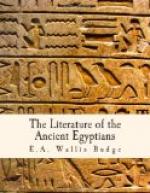BOOKS OF THE DEAD OF THE GRAECO-ROMAN PERIOD
From what has been said in the preceding chapter it will be clear that only wealthy people could afford to bury copies of the great Book of the Dead with their deceased relatives. Whether the chapters that formed it were written on coffins or on papyrus the cost of copying the work by a competent scribe must have been relatively very great. Towards the close of the twenty-sixth dynasty a feeling spread among the Egyptians that only certain parts of the Book of the Dead were essential for the resurrection of the body and for the salvation of the soul, and men began to bury with their dead copies of the most important chapters of it in a very much abridged form. A little later the scribes produced a number of works, in which they included only such portions of the most important chapters as were considered necessary to effect the resurrection of the body. In other words, they rejected all the old magical elements in the Book of the Dead, and preserved only the texts and formulae that appertained to the cult of Osiris, the first man who had risen from the dead. One of the oldest of these later substitutes for the Book of the Dead is the Shai en Sensen, or “Book of Breathings.” Several copies of this work are extant in the funerary papyri, and the following sections, translated from a papyrus in the British Museum, will give an idea of the character of the Book:
“Hail, Osiris[1] Kersher, son of Tashenatit! Thou art pure, thy heart is pure. Thy fore parts are pure, thy hind parts are cleansed; thy interior is cleansed with incense and natron, and no member of thine hath any defect in it whatsoever. Kersher is washed in the waters of the Field of Offerings, that lieth to the north of the Field of the Grasshoppers. The goddesses Uatchet and Nekhebet purify thee at the eighth hour of the night and at the eighth hour of the day. Come then, enter the Hall of Truth, for thou art free from all offence and from every defect, and ‘Stone of Truth’ is thy name. Thou enterest the Tuat (Other World) as one exceedingly pure. Thou art purified by the Goddesses of Truth in the Great Hall. Holy water hath been poured over thee in the Hall of Keb (i.e. the earth), and thy body hath been made pure in the Hall of Shu (heaven). Thou lookest upon Ra when he setteth in the form of Tem at eventide. Amen is nigh unto thee and giveth thee air, and Ptah likewise, who fashioned thy members for thee; thou enterest the horizon with Ra. Thy soul is received in the Neshem Boat of Osiris, thy soul is made divine in the House of Keb, and thou art made to be triumphant for ever and ever.”




